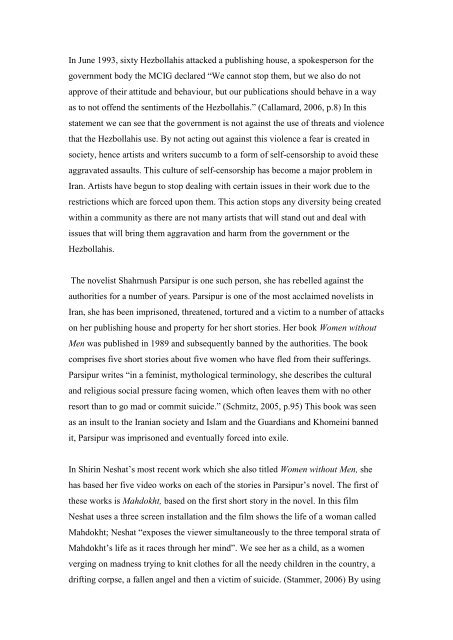A Gaze through the Veil:
A Gaze through the Veil:
A Gaze through the Veil:
You also want an ePaper? Increase the reach of your titles
YUMPU automatically turns print PDFs into web optimized ePapers that Google loves.
In June 1993, sixty Hezbollahis attacked a publishing house, a spokesperson for <strong>the</strong>government body <strong>the</strong> MCIG declared “We cannot stop <strong>the</strong>m, but we also do notapprove of <strong>the</strong>ir attitude and behaviour, but our publications should behave in a wayas to not offend <strong>the</strong> sentiments of <strong>the</strong> Hezbollahis.” (Callamard, 2006, p.8) In thisstatement we can see that <strong>the</strong> government is not against <strong>the</strong> use of threats and violencethat <strong>the</strong> Hezbollahis use. By not acting out against this violence a fear is created insociety, hence artists and writers succumb to a form of self-censorship to avoid <strong>the</strong>seaggravated assaults. This culture of self-censorship has become a major problem inIran. Artists have begun to stop dealing with certain issues in <strong>the</strong>ir work due to <strong>the</strong>restrictions which are forced upon <strong>the</strong>m. This action stops any diversity being createdwithin a community as <strong>the</strong>re are not many artists that will stand out and deal withissues that will bring <strong>the</strong>m aggravation and harm from <strong>the</strong> government or <strong>the</strong>Hezbollahis.The novelist Shahrnush Parsipur is one such person, she has rebelled against <strong>the</strong>authorities for a number of years. Parsipur is one of <strong>the</strong> most acclaimed novelists inIran, she has been imprisoned, threatened, tortured and a victim to a number of attackson her publishing house and property for her short stories. Her book Women withoutMen was published in 1989 and subsequently banned by <strong>the</strong> authorities. The bookcomprises five short stories about five women who have fled from <strong>the</strong>ir sufferings.Parsipur writes “in a feminist, mythological terminology, she describes <strong>the</strong> culturaland religious social pressure facing women, which often leaves <strong>the</strong>m with no o<strong>the</strong>rresort than to go mad or commit suicide.” (Schmitz, 2005, p.95) This book was seenas an insult to <strong>the</strong> Iranian society and Islam and <strong>the</strong> Guardians and Khomeini bannedit, Parsipur was imprisoned and eventually forced into exile.In Shirin Neshat’s most recent work which she also titled Women without Men, shehas based her five video works on each of <strong>the</strong> stories in Parsipur’s novel. The first of<strong>the</strong>se works is Mahdokht, based on <strong>the</strong> first short story in <strong>the</strong> novel. In this filmNeshat uses a three screen installation and <strong>the</strong> film shows <strong>the</strong> life of a woman calledMahdokht; Neshat “exposes <strong>the</strong> viewer simultaneously to <strong>the</strong> three temporal strata ofMahdokht’s life as it races <strong>through</strong> her mind”. We see her as a child, as a womenverging on madness trying to knit clo<strong>the</strong>s for all <strong>the</strong> needy children in <strong>the</strong> country, adrifting corpse, a fallen angel and <strong>the</strong>n a victim of suicide. (Stammer, 2006) By using




